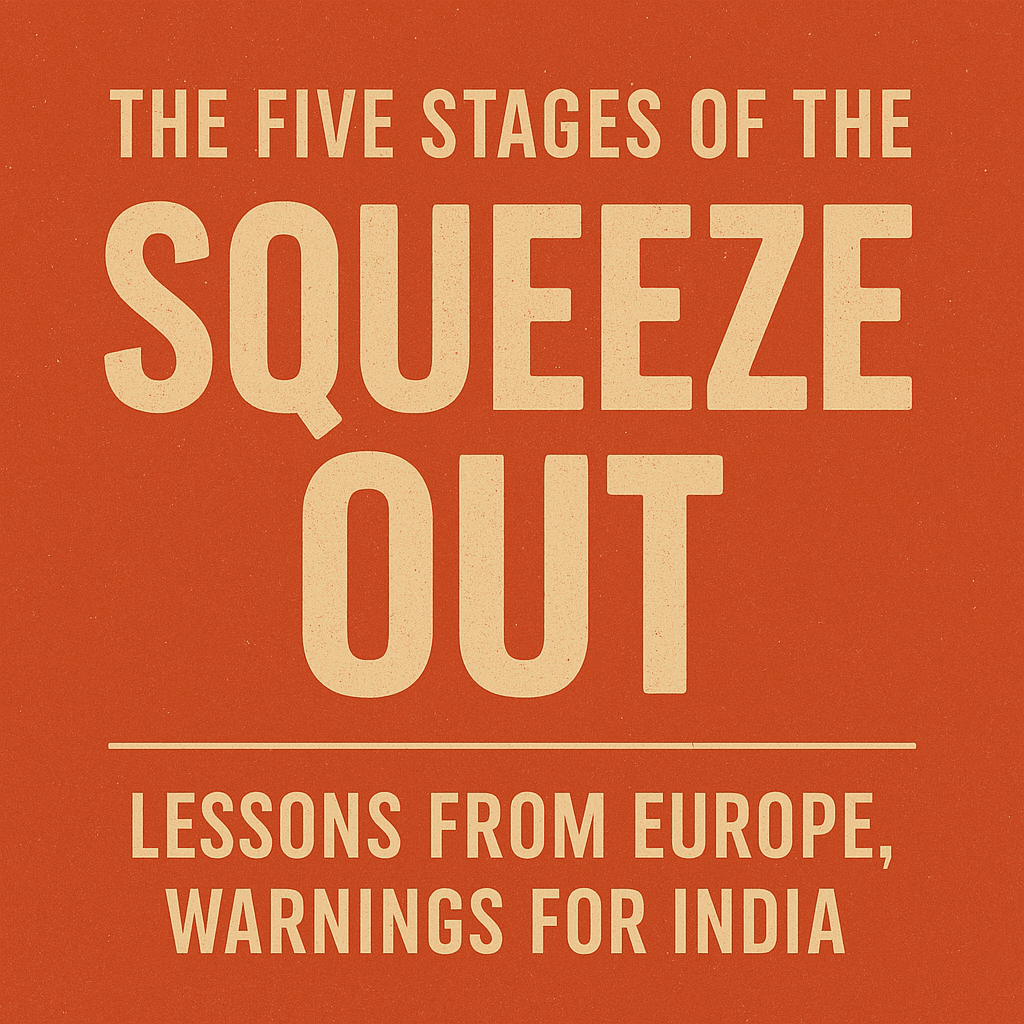
The Five Stages of the Squeeze Out: Lessons from Europe, Warnings for India
The Five Stages of the Squeeze Out: Lessons from Europe, Warnings for India
In today’s rapidly shifting global economy, the widening chasm between the ultra-rich and everyone else is no accident. It follows a grim but recognizable pattern that Gary Stevenson, a former trader and economist, describes as “The Squeeze Out.” While his analysis focuses on the UK, its structure applies eerily well to other nations experiencing similar economic transformations. This article outlines the five stages of the squeeze out, connects each to historical European precedents that led to war, and offers contemporary Indian parallels to help readers judge where we stand.
Stage 1: Asset Inflation Begins – The Seeds of Dispossession
Definition & Explanation
Tax cuts and capital accumulation allow the rich to invest heavily in assets. As real estate, stocks, and other investment vehicles surge in price, ordinary people are squeezed out of ownership. This feels good temporarily—house prices are up, savings grow—but it marks the start of dispossession as the working class sells assets to sustain daily life.
Europe – Historical Example:
In post-WWI Germany, hyperinflation eroded middle-class wealth. Families sold heirlooms and property just to survive. A concentration of wealth began, deepening class divides and destabilizing the Weimar Republic.
India – Contemporary Parallel:
Real estate booms in Indian cities have made homes unaffordable. Older generations sell inherited property to fund education or retirement. Microfinance loans rise in rural areas as land and gold are liquidated for survival.
Stage 2: Debt Explosion – Credit Sustains the Illusion
Definition & Explanation
With few assets left, the public turns to debt. Consumption continues via loans, EMIs, and informal lending. Eventually, defaults rise, credit dries up, and a financial crisis follows.
Europe – Historical Example:
The 1920s saw an explosion of credit in Europe and the US. When the 1929 crash came, both regions plunged into depression. Debt-fueled illusions of prosperity turned into mass unemployment and radical political shifts.
India – Contemporary Parallel:
From farmer suicides to credit card traps among youth, debt is omnipresent. Small businesses survive on loans. The 2016 demonetization and COVID lockdowns exposed the fragility of this debt-based survival.
Stage 3: Government Dissaving – Selling the State’s Soul
Definition & Explanation
To keep the economy afloat, the state steps in—not by taxing the rich, but by borrowing from them and selling public assets. State-owned enterprises and infrastructure are privatized. Government wealth collapses.
Europe – Historical Example:
Weimar Germany depended on U.S. loans while refusing to tax its industrialists. When loans dried up, the republic collapsed, creating space for authoritarianism.
India – Contemporary Parallel:
Massive privatization drives: Air India, BPCL, and LIC stakes. Government borrows heavily but avoids taxing billionaires. Budgets for education and healthcare stagnate while corporates thrive.
Stage 4: Middle-Class Erosion – Welfare Retraction and Service Collapse
Definition & Explanation
With no assets left, governments target the middle class. Taxes rise, public services degrade, and social safety nets fray. The middle class funds its own decline while receiving less in return.
Europe – Historical Example:
In the late 1930s, Britain and France slashed social spending. Fascist regimes offered conditional welfare tied to loyalty. Middle-class disillusionment eroded democratic resilience.
India – Contemporary Parallel:
Public hospitals and schools deteriorate. Middle-class families turn to costly private alternatives. Indirect taxes like GST hurt salaried professionals while ultra-rich corporations enjoy policy favors.
Stage 5: Final Capture – A Society Built Only for the Rich
Definition & Explanation
The working class, middle class, and government have been squeezed dry. The economy now caters only to the rich. Luxury real estate, private jets, and gated communities flourish. With no one left to exploit, the elite turn on each other—historically through war.
Europe – Historical Example:
By the late 1930s, Europe’s elite-driven societies collapsed into fascism and war. The Holocaust, colonial conquest, and World War II were outcomes of a world where wealth and power were too concentrated.
India – Contemporary Parallel:
Luxury towers rise beside sprawling slums. Surveillance, communal polarization, and privatized public goods mark a society stratified beyond repair. Billionaires shape policy while nationalism distracts the masses.
Conclusion: Choose Your Stage
The squeeze out is not merely an economic shift; it’s a transformation of society itself. It has happened before—and ended in war. In India today, the signs are visible across urban skylines, tax policies, and crumbling institutions. Whether we’re at Stage 3, 4, or 5 is not for one voice to declare. But if history teaches us anything, it’s that ignoring this trajectory only accelerates its consequences.
It is up to the public, the policymakers, and the press to stop the squeeze, before the last ounce of wealth, dignity, and democracy is gone.